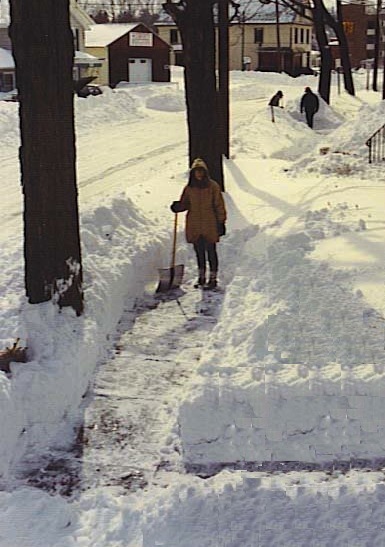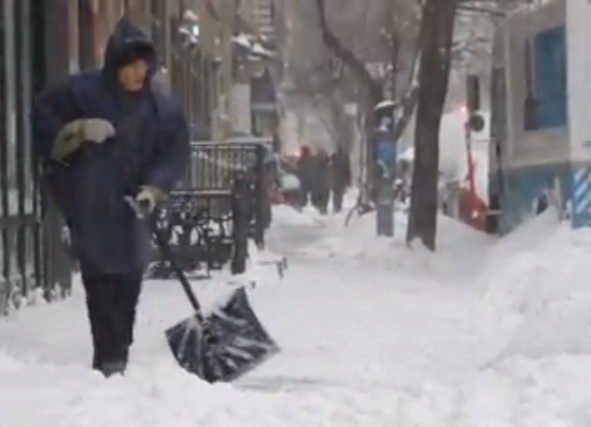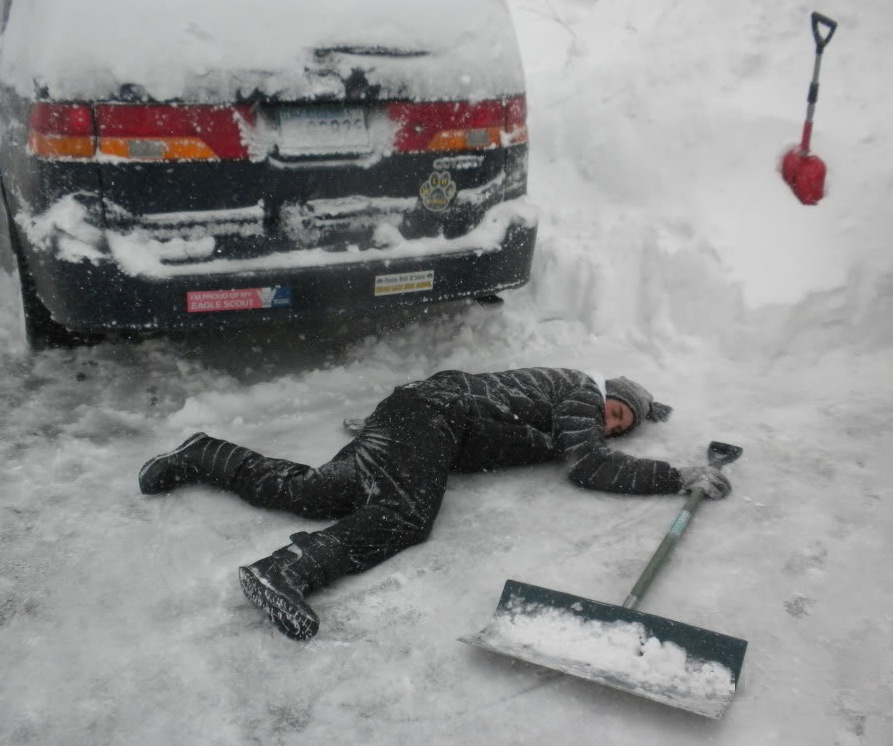DIGGING OUT FROM
WINTER STORMS
Shoveling snow, however,
remains a health hazard
By David Maril
For years, Baltimore was labeled Panic City when it came to predictions of snow.
Few who lived here would disagree.
The threat alone of frozen precipitation would launch the city and counties into activating snow emergency plans. Schools would open late and close early at the sign of a few snowflakes.
A slightly ominous weather forecast could spark a stampede to grocery stores as fears grew of being stranded at home for weeks without bread, milk and the necessities of modern life.
If we had an inch of snow, the Jones Falls Expressway often turned into a giant parking lot of cars headed for body shops after fender benders caused by petrified drivers slamming on their brakes when encountering slick spots and spinning out of control.
Don’t get me wrong, Baltimoreans still don’t like snow.
Stores continue to become mobbed after predictions of bad weather. And this latest snow episode we’ve had, sporadically dumping as much as 20 inches over several days in parts of Maryland, has sparked a wave of complaints that are symptomatic of extreme winter weariness.
However, let’s put this in perspective.
It’s important to recognize that we no longer seem to have as many accidents from panic in tough winter driving conditions.
The real telltale thing that has changed is, we now have plenty of company around the rest of the country in not adapting easily to snow, sleet and cold.
 Look what happened recently in Atlanta, with thousands of commuters stranded on highways overnight after snow and sleet. The way commentators were talking about that southern city’s being unprepared and not used to dealing with snow sounded like a description of Baltimore 25 years ago.
Look what happened recently in Atlanta, with thousands of commuters stranded on highways overnight after snow and sleet. The way commentators were talking about that southern city’s being unprepared and not used to dealing with snow sounded like a description of Baltimore 25 years ago.
New England is another prime example. After growing up in Baltimore, I lived in Massachusetts for a number of years and people there used to be tough when it came to snow. They laughed at news stories out of Baltimore, Washington and Philadelphia, calling off school because of three-inch snowstorms.
SLIGHT CHANCE OF SNOW
Things, however, have changed. Today in New England, every time there’s even a slight chance of a snowstorm three or four days away, supermarkets are swamped by shoppers even more frantic than Baltimoreans facing bad weather. Meteorologists on the four major Boston stations build careers out of making a dusting of snow sound more dangerous than an earthquake.
It never used to be this way.
New Englanders had always accepted snow as an insignificant factor that comes with winter. TV weathermen existed primarily to provide a change of pace from the news, mixing in some area temperatures while bantering with the personalities on the anchor desk.
Even before the days of SUVs and pricey all-wheel-drive cars, New Englanders would simply go out, shovel their car wheels clear, clean off the windshield and hit the road, covered by a half-foot of packed-down snow.
BEFORE EVERYTHING CHANGED
This was before highway department crews were expected to flood roads with salt, chemicals and sand whenever a few flakes began sticking. This was before it was a common sight to see plows pushing their blades hard enough on street surfaces for sparks to fly.
Everything changed in 1978.
Psychologically, New Englanders still have not recovered from the infamous and devastating “Blizzard of ‘78” that whacked the region.
People who experienced that storm have not forgotten how it surprised and paralyzed everything. And they have passed this anxiety over snow, on to their children.

The ‘Beanpot’ is a 61-year-old men’s ice hockey tournament involving Boston Col- lege and Harvard, Boston and Northeast- ern Universities — the four major college hockey schools of the Boston area — held annually on the first two Monday nights of February since the 1952-53 season. This year’s tournament was won last week by Boston College, the school’s fifth consecutive Beanpot championship.
Despite predictions of moderate accumulation, the 1978 storm intensified and lingered for days, dumping several feet of snow. Thousands of commuters had to abandon their cars on highways. Many of the fans attending the “Beanpot” ice hockey tournament ended up spending the night in the old Boston Garden.
For a week after the snow finally stopped, people were still trying to dig out their cars, buried out of sight under snowdrifts. Many towns and cities issued curfews to give plowing crews access at clearing the mounds of snow off the roads.
CLASSIC SYMPTOMS OF CABIN FEVER
Although families who hadn’t done any pre-storm shopping were running low on milk and bread, many stores remained closed. With most people confined to their homes, boredom, impatience and a feeling of helplessness — the classic symptoms of cabin fever — set in.
The Boston meteorologists on television and radio were suddenly thrown into the spotlight and absorbed extreme criticism for underestimating the storm.
The impact of that 1978 snowstorm still lingers.
Learning how unforgiving the public is when a storm hits by surprise, Boston meteorologists now cover their tracks by predicting the worst. They use terms like, “This could be a storm of significance” for anything over an inch.
Having moved back to Baltimore, I can honestly say people in Maryland now handle snow and bad weather as well as New Englanders. Highway crews here today are well equipped to deal with inclement weather and can hold their own with road maintenance staffs in other parts of the country.
Perhaps it’s the influence of all-wheel and front-wheel drive, but we seem to have gotten a little more poised, driving in bad conditions. At the same time, other regions of the country are not as stoic and tough as they used to be.
INEPT DRIVING IN BAD WEATHER
While accidents in Baltimore from inept driving in bad weather seem to have declined, we often overlook one of the most dangerous safety aspects of snowstorms — shoveling sidewalks and parking areas.
Once the storms are over, the tendency is to view the cleanup process as a natural winding down following the big event. Too often, common sense and health concerns are ignored and people who generally refrain from participating in rigorous physical activity, grab shovels and clear heavy snow as if they have been training for a triathlon.
Drive around neighborhoods after a snowstorm and you’ll see people in their 60s and 70s tossing shovelsful of snow into drifts along their sidewalks. You can also usually find middle-aged people who are noticeably overweight out there huffing and puffing, pushing and lifting shovels filled with heavy snow.
We all, unfortunately, can recall people who shouldn’t have been shoveling ending up suffering heart attacks. They are not used to heavy lifting and it’s an added shock to their system, breathing in cold air. The results are often fatal.
CAUTION TO THE WIND
What causes this lapse in judgment? These are people who would not suddenly go out and play in a full-court basketball game or chop firewood. Why in the world are they so quick to throw heavy snow — and caution — to the wind? Why doesn’t someone talk them out of taking such a risk?
Certainly there’s a safety concern of wanting to clear the sidewalks so pedestrians won’t slip and fall. But why put your own life on the line if you are not in shape to shovel?
Is it a case of honor and self-respect asserting that no matter what your physical condition, you can still clear your own sidewalk? If so, why not buy a snowblower?
Aren’t there any teens left in neighborhoods who want to earn some extra money shoveling snow and are willing to pry themselves away from their high tech gadgets and devices long enough to do so?
No matter what region of the country, scraping, shoveling and cleaning up after the storm can be even more dangerous than bad driving while the snow is coming down.
davidmaril@hermanmaril.com
“Inside Pitch” is a weekly opinion column written for Voice of Baltimore by David Maril.
CHECK OUT LAST WEEK’S “INSIDE PITCH” COLUMN: click here
…and read previous Dave Maril columns by clicking here.








February 22nd, 2014 - 7:33 AM
[…] OUT LAST WEEK’S “INSIDE PITCH” COLUMN: click here …and read previous Dave Maril columns by clicking here. Filed under: Top Stories […]